Physical Address
304 North Cardinal St.
Dorchester Center, MA 02124
| 17-Hydroxyprogesterone caproate | 17-OH-P |
| American College of Obstetricians and Gynecologists | ACOG |
| Arterioarterial | AA |
| Arteriovenous | AV |
| Artificial reproductive technology | ART |
| Body mass index | BMI |
| Deepest vertical pocket | DVP |
| Dichorionic | DC |
| Dichorionic diamniotic | DCDA |
| Disseminated intravascular coagulation | DIC |
| Dizygotic | DZ |
| Estimated fetal weight | EFW |
| Fetal fibronectin | fFN |
| Follicle-stimulating hormone | FSH |
| Gestational diabetes | GDM |
| Institute of Medicine | IOM |
| Intrauterine fetal death | IUFD |
| Intrauterine growth restriction | IUGR |
| In vitro fertilization | IVF |
| Low birthweight | LBW |
| Magnetic resonance imaging | MRI |
| Middle cerebral artery | MCA |
| Monoamniotic | MA |
| Monochorionic | MC |
| Monochorionic diamniotic | MCDA |
| Monochorionic monoamniotic | MCMA |
| Monozygotic | MZ |
| Multifetal pregnancy reduction | MPR |
| Multiples of the median | MoM |
| National Institute of Child Health and Human Development | NICHD |
| Neonatal intensive care unit | NICU |
| North American Fetal Therapy Network | NAFTNet |
| Peak systolic velocity | PSV |
| Preterm birth | PTB |
| Preterm prelabor rupture of membranes | PPROM |
| Radiofrequency ablation | RFA |
| Randomized controlled trial | RCT |
| Selective intrauterine growth restriction | sIUGR |
| Selective termination | ST |
| Small for gestational age | SGA |
| Society for Maternal-Fetal Medicine | SMFM |
| Spontaneous preterm birth | SPTB |
| Transvaginal cervical length | TVCL |
| Twin anemia-polycythemia sequence | TAPS |
| Twin reversed arterial perfusion | TRAP |
| Twin-twin transfusion syndrome | TTTS |
| Vanishing twin syndrome | VTS |
| Venovenous | VV |
| Very low birthweight | VLBW |
| World Health Organization | WHO |
The increase in multiple births during the past 30 to 40 years has been well documented, making multiple gestations among the most common high-risk conditions encountered by obstetricians. The increase in multiple births has been attributed to assisted reproductive technology (ART) as well as older maternal age at childbirth, a known risk factor for spontaneous dizygotic (DZ) twinning. Over the three decades between 1980 and 2009, the twin birth rate rose by 76%, from 18.9 per 1000 to 33.2 per 1000 births. The twin birth rate was then generally stable from 2009 through 2012 but subsequently peaked in 2014 with the highest rate ever recorded at 33.9 per 1000 births. The most current available data are from 2015 and show a slight decrease to 33.5 per 1000 births. Likewise, rates of triplets and higher-order multiples increased by more than 400% during the 1980s and 1990s, reaching an all-time high in 1998 of 193.5 per 100,000. Since then, the rate has trended downward. The 2015 rate of 103.6 per 100,000 births is the lowest since 1994.
Twins can be either monozygotic (MZ) or DZ. Zygosity refers to the genetic makeup of the twin pregnancy, and chorionicity indicates the pregnancy's placental composition ( Fig. 39.1 ). Chorionicity is determined by the mechanism of twinning and, in MZ twins, by the timing of embryo division. Determination of chorionicity should be established as early as possible in every multifetal pregnancy, as chorionicity is a major factor in determining obstetric risks and management. Because they result from the fertilization of two different ova by two separate sperm, DZ twins always develop dichorionic (DC) diamniotic placentation. A MZ twin pregnancy is created by the fertilization of one egg by one sperm and subsequent spontaneous cleavage of the fertilized ovum. The types of placentation are determined by the timing of this cleavage ( Table 39.1 ).
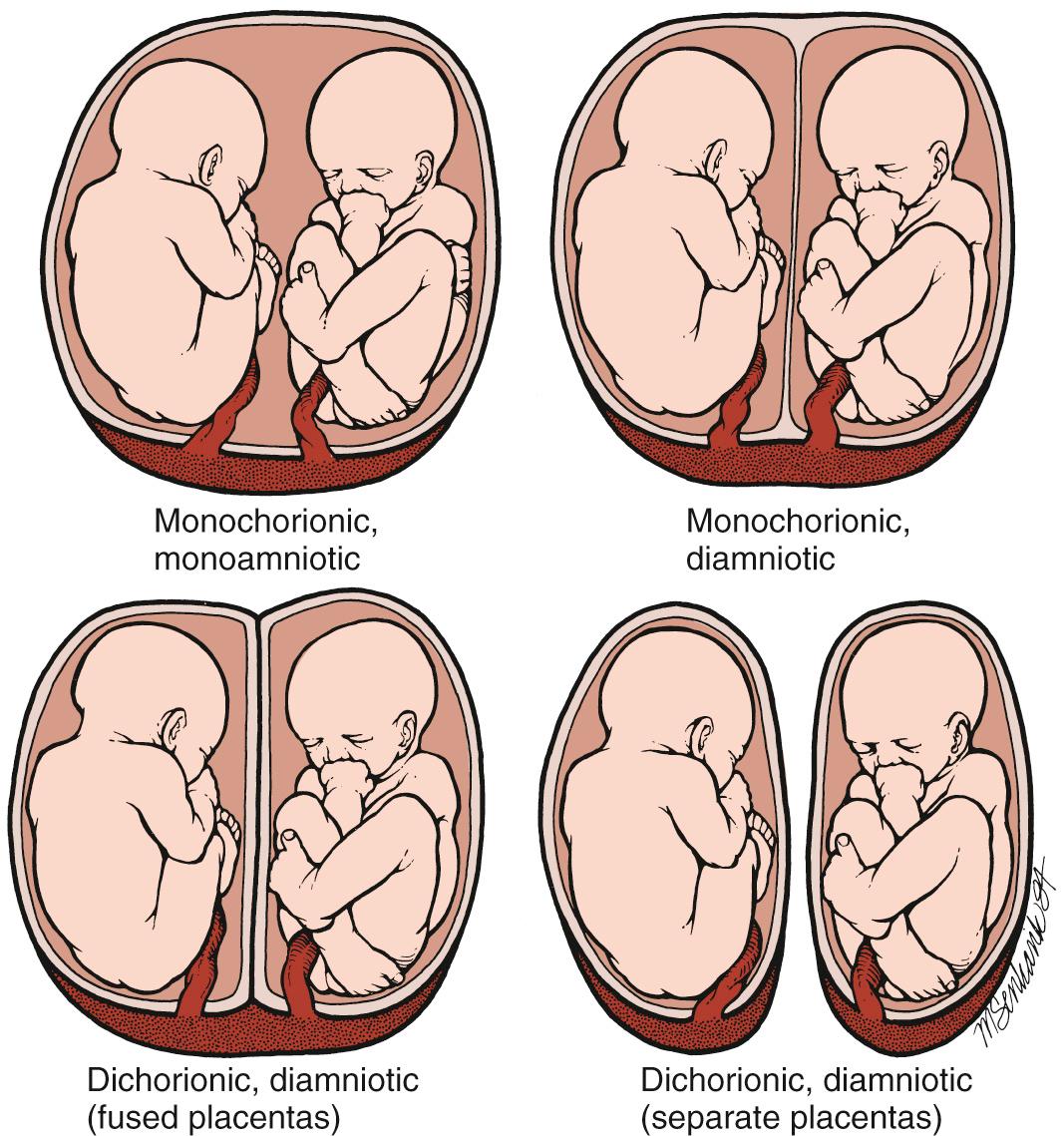
| Timing of Cleavage of Fertilized Ovum | Resulting Placentation | Percentage of Monozygotic Twins |
|---|---|---|
| <72 h | Diamniotic dichorionic | 25–30 |
| Days 4–7 | Diamniotic monochorionic | 70–75 |
| Days 8–12 | Monoamniotic monochorionic | 1–2 |
| ≥Day 13 | Conjoined | Very rare |
MZ twins are at higher risk for adverse outcomes. Not only do MZ twins have higher rates of anomalies than DZ twins, they also deliver earlier and have lower birthweights and higher rates of perinatal death. However, several studies, including one that used DNA analysis to confirm zygosity, have shown that monochorionicity, rather than monozygosity per se, is the determining factor.
Among natural conceptions, DZ twins arise in about 1% to 1.5% of pregnancies and MZ twins occur in 0.4% of pregnancies. Rates of spontaneous DZ twinning are affected by maternal age, family history, and race. The risk for DZ twinning increases with maternal age and peaks at 37 years of age. Maternal family history, particularly in first-degree relatives, also increases the chance of spontaneous DZ twinning. Paternal family history contributes little or nothing to this risk. Finally, women of West African descent have higher rates of DZ twinning than white women, who in turn have higher rates than women of Asian descent. For instance, in Japan, 1 in 250 newborns is a twin, whereas in Nigeria, 1 in 11 babies is a product of a twin gestation.
The causes of DZ twinning are better understood than the causes of MZ twinning. DZ twins result from multiple ovulation, which is associated with higher maternal levels of follicle-stimulating hormone (FSH). FSH levels, and thus rates of DZ twinning, vary with season, geography, maternal age, and body habitus. Increases in DZ twinning have been reported in summer months and in locations with more daylight and also in taller, heavier, and older mothers. Higher rates of DZ twinning have also been reported following discontinuation of birth control pills, presumably due to a rebound in FSH levels after hormonal suppression.
MZ twinning is less well understood. No naturally occurring animal models for MZ twinning exist except for armadillos, which produce MZ quadruplets or octuplets. Theories for MZ twinning include fertilization of an “old” ovum with a more fragile zona pellucida or inadequate cytoplasm and with damage to the inner cell mass leading to two separate points of regrowth and splitting of the fertilized ovum. Rates of MZ twinning are constant across all population and demographic variables with the exception of assisted reproduction. In vitro fertilization (IVF) and ovulation induction have been shown to produce higher rates of MZ twins. Against a spontaneous rate of 0.4% in the general population, studies of MZ twinning report rates more than 10-fold higher in pregnancies conceived by assisted fertility.
Prenatal ultrasound is invaluable for the early diagnosis of a multiple gestation. Using transvaginal ultrasound, separate gestational sacs with individual yolk sacs can be identified as early as 5 weeks from the first day of the last menstrual period, and embryos with cardiac activity can usually be seen by 6 weeks. The sonographer must be compulsive in examining the entire uterine cavity to avoid under- or overdiagnosing a multiple gestation. In particular, monochorionic (MC) twins can be misdiagnosed as a singleton early in pregnancy if the ultrasound examination is not meticulous.
A 2010 editorial argued that “there is no diagnosis of twins,” saying that all twin gestations must be further classified at diagnosis as either MC or DC. Knowledge of chorionicity is essential in counseling patients on obstetric and neonatal risks. Chorionicity is also crucial in planning antenatal management because MC twin gestations require closer surveillance for complications unique to the shared placenta, such as twin-twin transfusion syndrome (TTTS).
Determination of chorionicity is easiest and most reliable when it is assessed in the first trimester. Between 6 and 10 weeks, counting the number of gestational sacs and evaluating the thickness of the dividing membrane is the most reliable method of determining chorionicity ( Table 39.2 ). Two separate gestational sacs each containing a fetus and a thick dividing membrane represent a dichorionic diamniotic (DCDA) pregnancy, whereas one gestational sac with a thin dividing membrane and two fetuses suggests a MC diamniotic pregnancy ( Fig. 39.2 ). For MC gestations, the dividing amniotic membrane may be very difficult to visualize in the first trimester. However, with rare exceptions, the number of amniotic sacs will be the same as the number of yolk sacs, which are relatively easy to count in early gestation.
| Placentation | Gestational Sacs | Amniotic Cavities | Yolk Sacs |
|---|---|---|---|
| Dichorionic diamniotic | 2 | 2 (thick dividing membrane) | 2 |
| Monochorionic diamniotic | 1 | 2 (thin dividing membrane) | 2 |
| Monochorionic monoamniotic | 1 | 1 | 1 a |
a Although this is nearly always true, there have been case reports of two yolk sacs in early pregnancy with twins later confirmed to be monoamniotic.
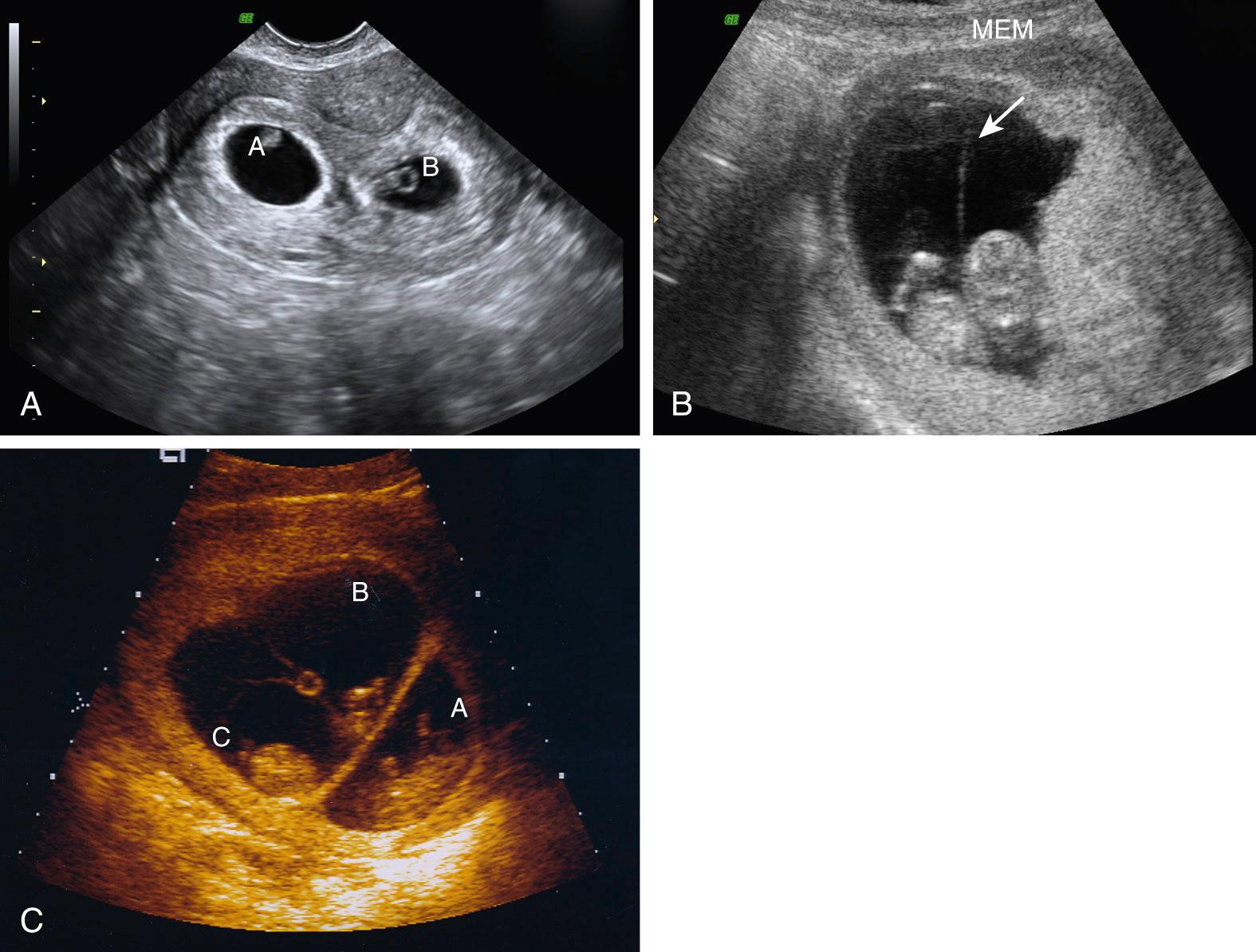
After 9 weeks, the dividing membranes become progressively thinner, but they remain thicker and easy to identify in DC pregnancies. By 11 to 14 weeks of gestation, sonographic examination of the base of the intertwin membrane for the presence or absence of the lambda or twin-peak sign provides reliable distinction between a MC and a fused DC pregnancy. The twin-peak sign is a triangular projection of tissue that extends beyond the chorionic surface of the placenta ( Fig. 39.3 ). This tissue is insinuated between the layers of the intertwin membrane; it is wider at the chorionic surface and tapers to a point at some distance inward from that surface. This finding is produced by the extension of chorionic villi into the potential interchorionic space of the twin membrane, where it encounters the placenta of the co-twin. The twin-peak sign cannot occur in MC placentation because the single continuous chorion does not extend into the potential interamniotic space between the monochorionic diamniotic (MCDA) twin membranes. In MC gestations, the interaction of the amniotic membranes with the chorionic surface is flush and is referred to as the T sign ( Fig. 39.4 ).
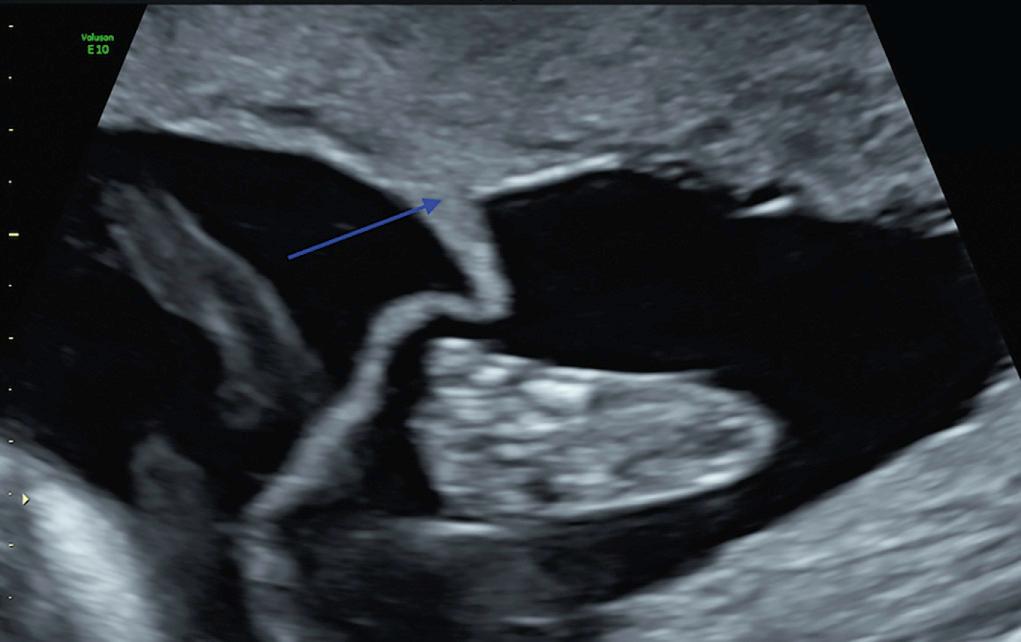
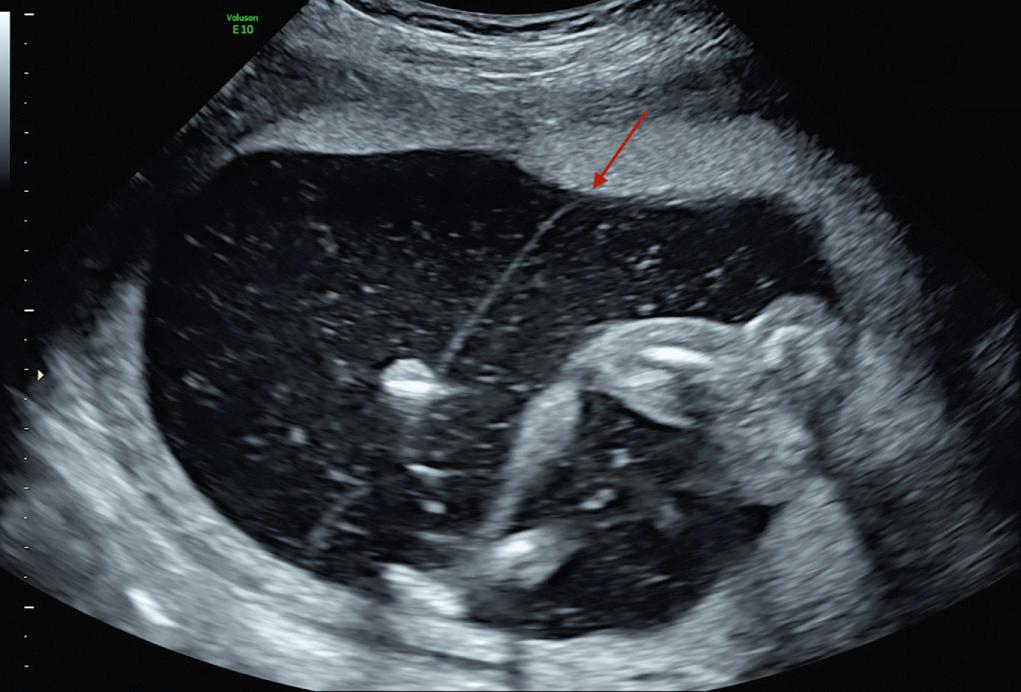
After the early second trimester, determination of chorionicity and amnionicity becomes less accurate and different techniques are used ( Fig. 39.5 ). The sonographic prediction of chorionicity and amnionicity should be systematically approached by determining the number of placentas and the sex of each fetus and then by assessing the membranes that divide the sacs. The dividing membranes may be difficult to visualize sonographically in some MCDA pregnancies because they are very thin. In other cases they may not be seen because severe oligohydramnios causes them to be closely apposed to the fetus in that sac. This results in a “stuck twin” appearance, in which the trapped fetus remains firmly held against the uterine wall despite changes in maternal position. In most cases a small portion of the dividing membrane can be seen extending from a fetal edge to the uterine wall ( Fig. 39.6 ). This condition must be distinguished from a monoamniotic (MA) gestation, in which dividing amniotic membranes are absent. In the latter situation, free movement of both twins—and entanglement of their umbilical cords—can be demonstrated.
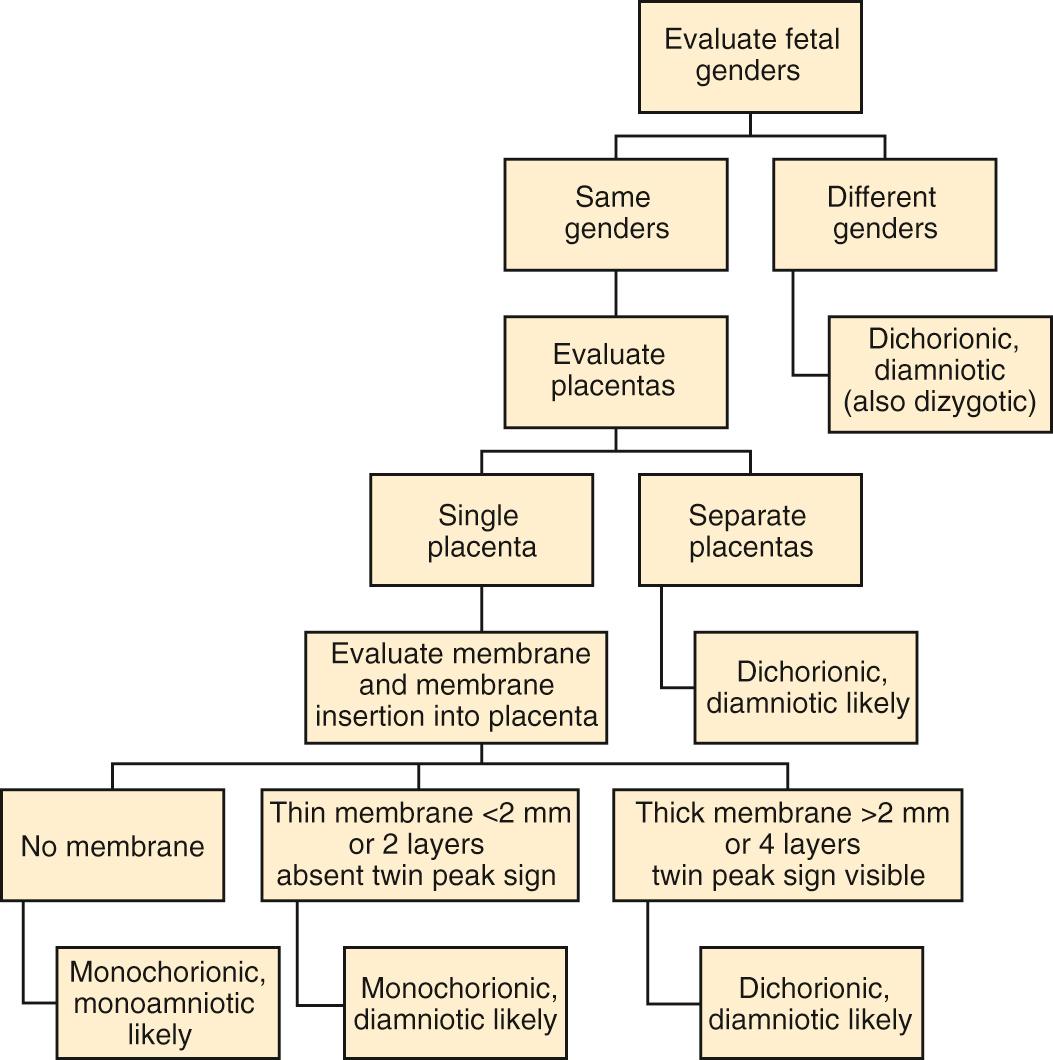
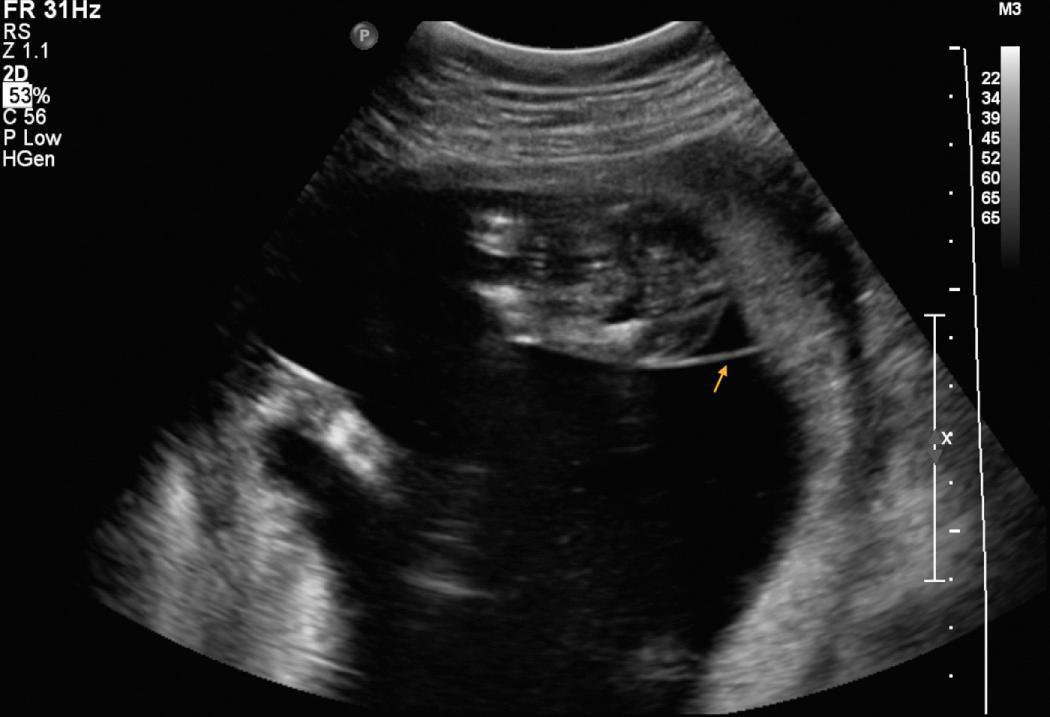
If a twin set is MC, monozygosity can be inferred. If the twins are of different genders, they can be assumed to be DZ with very rare anecdotal exceptions. Based on these two findings, approximately 55% of all twins’ zygosity can be determined by clinical examination of the babies and placentas. Conversely, 45% of all twins (same-sex DC twins) would need further genetic testing to determine zygosity.
The degree of maternal physiologic adaptation to pregnancy is exaggerated with a multiple gestation. Levels of maternal progesterone, estriol, cortisol, and human chorionic somatomammotropin (placental lactogen) are higher in multiple gestations than in singletons. Increased human placental lactogen modifies maternal metabolism and is thought to be associated with the increased risk for gestational diabetes seen in multifetal pregnancies. Increased production of multiple placental proteins such as human chorionic gonadotropin may contribute to clinical conditions such as a greater risk for hyperemesis, and it complicates the interpretation of both first- and second-trimester maternal serum screening tests for aneuploidy. Both heart rate and stroke volume are increased compared with that of singleton gestations, thus increasing cardiac output. In addition to these cardiac changes, plasma volume expansion and total body water are remarkably increased in twin gestations. Partially because of increased total body water, colloid oncotic pressure is reduced. Clinical effects of the decreased colloid oncotic pressure are increased dependent edema and a greater risk for pulmonary edema.
As described previously, serum protein concentrations are decreased during pregnancy. Although this is partially due to increased total body water, some degree of reduced hepatic contribution of serum proteins is also likely and exaggerated in multifetal gestations compared with singleton pregnancies. A 2014 study of 50 twin and 49 singleton pregnancies compared 24-hour urinary protein at 24 to 36 weeks of gestation. The women were all without evidence of hypertensive disorders at the time the urine was collected. Twin mothers had 269.3 ± 124.1 mg of protein/24 hours compared with 204.3 ± 92.5 mg for singleton mothers ( P = .004). Even excluding those women who later developed a hypertensive disorder, the increased degree of proteinuria in those carrying twins persisted (24-hour urine 278.9 ± 138.7 vs. 202.4 ± 92.1 mg, P = .007). Among women who were not diagnosed with a hypertensive disorder, 43% of twin mothers had more than 300 mg/day compared with 7% of singleton mothers. This increased renal protein excretion may also contribute to lower serum protein in mothers pregnant with twins and has implications for the diagnosis of preeclampsia in multiples.
Virtually every obstetric complication with the exception of macrosomia and postterm gestation is more common with multiple gestations. In general the risk rises proportionally to increasing plurality. Table 39.3 provides the relative risks (RRs) for various obstetric complications in twin gestations compared with singletons. In addition to the conditions listed in the table, multiples are associated with higher rates of gestational diabetes and rare but life-threatening conditions such as acute fatty liver and peripartum cardiomyopathy. Women pregnant with multiples not only have higher risks for developing certain adverse obstetrical conditions but also are more likely to have more severe manifestations of those conditions. Sibai and associates showed not only that mothers of twins are more likely to develop preeclampsia (RR, 2.62; 95% confidence interval [CI], 2.03 to 3.38) but also that twin mothers with preeclampsia have higher rates of delivery before 37 weeks and before 35 weeks as well as higher rates of placental abruption and small-for-gestational-age (SGA) infants than singleton mothers with preeclampsia. Atypical presentations of preeclampsia are also more common in multifetal gestations, especially triplets and higher-order multiples. One retrospective review of 21 triplet and 8 quadruplet pregnancies found that only half of the women delivered for preeclampsia had elevated blood pressures before delivery. Furthermore, proteinuria was present in only 3 of 16 women before delivery. Predominant presentations of preeclampsia in this series were laboratory abnormalities (chiefly elevated liver enzymes) and maternal symptoms. One theory for the higher incidence of atypical preeclampsia in women with triplet and higher-order multiples is that the exaggerated hemodynamic changes found in higher-order multiples may mask the “typical” maternal manifestations of preeclampsia.
| Singleton ( n = 71,851) (%) | Twin ( n = 1694) (%) | RR | 95% CI | |
|---|---|---|---|---|
| Hyperemesis | 1.7 | 5.1 | 3.0 | 2.1–4.1 |
| Threatened spontaneous abortion | 18.6 | 26.5 | 1.4 | 1.3–1.6 |
| Anemia | 16.2 | 27.5 | 1.7 | 1.5–1.9 |
| Abruption | 0.5 | 0.9 | 2.0 | 1.2–3.3 |
| Gestational hypertension | 17.8 | 23.8 | 1.3 | 1.2–1.5 |
| Preeclampsia | 3.4 | 12.5 | 3.7 | 3.3–4.3 |
| Eclampsia | 0.1 | 0.2 | 3.4 | 1.2–9.4 |
| Antepartum thromboembolism | 0.1 | 0.5 | 3.3 | 1.3–8.1 |
| Manual placental extraction | 2.5 | 6.7 | 2.7 | 2.2–3.2 |
| Evacuation of retained products | 0.6 | 2.0 | 3.1 | 2.0–4.8 |
| Primary PPH (>1000 mL) | 0.9 | 3.1 | 3.4 | 2.9–4.1 |
| Secondary PPH | 0.6 | 1.7 | 2.6 | 1.8–4.6 |
| Postpartum thromboembolism | 0.2 | 0.6 | 2.6 | 1.1–5.9 |
These increased maternal risks extend to life-threatening morbidity and even mortality. A recent French cohort-nested case control analysis compared 2500 women with severe acute maternal morbidity with 3650 women without severe acute maternal morbidity. Severe maternal morbidity included a long list of complications such as ICU admission, transfusion of 4 or more units of red blood cells, eclampsia, pulmonary embolism, stroke, and cardiac failure, along with several other criteria. In multivariable analysis, twin pregnancies had an adjusted OR of 4.2 (95% CI, 3.1 to 5.8) for severe maternal morbidity compared with singleton gestations. Even when adjusted for confounders and access to care, many adverse outcomes in twin pregnancies have been shown to be more likely in nonwhite women. Finally, although fortunately still a very rare event, maternal death is increased in multifetal gestations. A study based on the World Health Organization Multicountry Survey Data comparing 4756 twin deliveries with 308,111 singleton deliveries reported that maternal death was 3.97 times more common (95% CI, 2.47 to 6.38) in twin pregnancies. A similar degree of elevated risk has been reported in European countries.
An important question is whether twin chorionicity alters the risk of maternal complications. A retrospective review of all twin pregnancies at a single institution between 1990 and 2010 provides helpful data. The cohort included 1747 DC and 554 MC twin pregnancies. Consistent with prior studies, MC twins had higher risks of delivery at less than 34 and 28 weeks of gestation, intrauterine fetal death (IUFD), and neonatal intensive care unit (NICU) admission. However, when outcomes of preeclampsia, gestational diabetes mellitus (GDM), and cesarean delivery were examined in multivariate analysis, there was no statistically significant difference in the risk of these outcomes in DC versus MC twins. This information may be helpful in counseling women pregnant with MC twins. Although there are higher fetal risks in MC pregnancies, the maternal risks are not altered by chorionicity.
Babies who are products of multiple gestations have higher rates of low birthweight (LBW), very low birthweight (VLBW), earlier gestational age at delivery, and higher rates of neonatal and infant death and cerebral palsy ( Table 39.4 ). One in 10 twins and 1 in 3 triplets are born before 32 weeks of gestation compared with just over 1 in 100 singletons. Infant death rates are approximately 4 times higher for twins, 12 times higher for triplets, and more than 25 times higher for quadruplets. Rates of cerebral palsy in multifetal gestation have been estimated to be between 5 and 10 per 1000 compared with 1 to 2 per 1000 for singletons. Much of this increased risk is attributable to higher rates of early preterm delivery and VLBW in multiple gestations. Notably, although the overall rates of cerebral palsy are higher in twins than in singletons, LBW preterm twins do not have higher rates than similar-weight gestational age–matched singletons. Several studies, however, have demonstrated higher rates of cerebral palsy for twins born at term weighing more than 2500 g than for comparable term singletons. This difference is mostly a reflection of the effect of monochorionicity.
| Mean Birth Weight a (g) | Mean Gestational Age at Delivery a (Week) | Delivery <32 Weeks of Gestation (%) | LBW (%) (<2500 g) | VLBW (%) (<1500 g) | |
|---|---|---|---|---|---|
| Singletons | 3309 | 38.6 | 1.2 | 6.3 | 1.1 |
| Twins | 2348 | 35.1 | 10.7 | 55.4 | 9.6 |
| Triplets | 1652 | 31.7 | 37.1 | 95.7 | 36.4 |
| Quadruplets | 1135 | 28.1 | 81.1 | 98.6 | 79.1 |
| Quintuplet and higher order | 880 | 27.3 | 95.8 | 100 | 100 |
a Calculated from National Center for Health Statistics. Vital statistics data available. Natality public use file and CD–ROM. Hyattsville, MD: National Center for Health Statistics. http://www.cdc.gov/nchs/data_access/VitalStatsOnline.htm .
Fetuses in multiple gestations are known to be at increased risk for anatomic abnormalities, and much of this increased risk is associated with MZ twinning. A 2009 population-based study from England found that rates of congenital anomalies were 1.7 times more frequent in twins compared with singletons (95% CI, 1.5 to 2.0) and that the RR for MC twins was nearly twice that of DC twins (RR, 1.8, 95% CI, 1.3 to 2.5). A Taiwanese series of 844 twin sets compared with 4573 singletons found a doubling of the RR of major congenital malformations in the twins. When broken down by zygosity, the RRs were 1.7 for DZ twins and 4.6 for MZ twins, with an anomaly prevalence of 0.6% for singletons, 1% for DZ twins, and 2.7% for MZ twins. Anomalies were concordant in 18% of the MZ twins but in none of the DZ twins. The overall evidence supports an approximately twofold increased risk for congenital anomalies in twins versus singletons, with most of this risk occurring in MZ twins.
In these studies, anomalies were seen in all organ systems. However, as is true in the general population as well, one of the most commonly involved organ systems was the heart. Although some studies have also found an increased risk of cardiac anomalies in DC twins, the risk is greatest for MC twins. A retrospective review of all MC twin pregnancies in the Kaiser Permanente system between 1996 and 2003 found a prevalence of congenital cardiac anomalies of 7.5% ( n = 69) in the 926 babies studied. These 69 congenital cardiac anomalies, which included only lesions that were confirmed on postnatal echocardiograms and persisted to 1 year of age, represented an 11.6-fold increased risk over the general population. The 2015 American Heart Association Statement on fetal cardiac disease cites a 2% to 10% risk of congenital cardiac disease in MC twins and recommends fetal echocardiography for all MC twins. The recommendation for fetal echocardiography at 18 to 22 weeks for all MC twins is also endorsed by the Society for Maternal-Fetal Medicine (SMFM) and the North American Fetal Therapy Network (NAFTNet).
The so-called vanishing twin refers to the loss of one fetus in a multiple gestation early in pregnancy . It is a fairly common occurrence and is typically either asymptomatic or associated with spotting or mild bleeding. Dickey and colleagues performed serial ultrasounds to assess the natural history of early pregnancy in multifetal gestation. The first ultrasound examination was performed at 3.5 to 4.5 weeks postovulation, and a scan was repeated every 2 weeks until 12 weeks of gestation. Spontaneous loss of one or more sacs occurred in 36% of twins, 53% of triplets, and 65% of quadruplets. Most of these losses were recognized before 9 weeks of gestation. Other investigators have shown that, not unexpectedly, the earlier the initial ultrasound, the greater the chance of a vanishing twin phenomenon. Additionally, MC twin gestations are at higher risk for either a vanishing twin or a complete pregnancy loss than are DC twins.
Obstetricians will not infrequently be faced with counseling women who have experienced loss of one embryo in a twin gestation. Most of the available data on this issue come from pregnancies conceived via assisted reproduction. Although not all studies are consistent, the bulk of the data shows a small decrease in birthweight and a slightly earlier gestational age at delivery for babies born from pregnancies complicated by a vanishing twin. A recent paper utilizing a Norwegian population-based registry is also one of the largest studies available. The study population consisted exclusively of pregnancies conceived by assisted reproduction and included 17,291 singleton pregnancies that had not experienced a vanishing twin syndrome (VTS) and 638 singletons that had experienced a VTS. Compared with singletons without VTS, singletons with VTS had lower mean birthweights (116 g less: 95% CI, −165 to −67). This paper also compared the singletons with VTS to their own singleton siblings without VTS (likewise conceived via ART) and found that the difference in birthweight persisted (adjusted mean difference in birthweight of −112 g: 95% CI, −209 to −15). There was no statistically significant difference in gestational age at delivery or risk of preterm delivery in this study. Information on gestational age at the time of the vanishing twin was not available, which is also a limitation of many other studies on this topic. It is reasonable to assume that the earlier the embryonic loss occurs, the less the effects on the survivor.
A reasonable approach to counseling and managing a pregnancy complicated by a first-trimester vanishing twin is to reassure the parents that the most likely outcome will be a healthy term or near-term baby. Because of the reports of lower birthweights and the increased risk of SGA, a third-trimester growth scan is reasonable.
The risk associated with multiple gestations is directly proportional to the number of fetuses being carried. First-trimester multifetal pregnancy reduction (MPR) has been advocated as a method for reducing the risks associated with higher-order plurality. MPR is an outpatient procedure usually performed between 10 and 13 weeks of gestation. Chorionic villus sampling can be performed on some or all the fetuses prior to the procedure to confirm normal chromosomal makeup. Ultrasound is used to map the location of each fetus, and nuchal translucencies are measured. Any fetus with an abnormal nuchal translucency that is SGA, appears anatomically abnormal, or is known to have a chromosomal abnormality is selected for reduction. If a MC twin component is present in a higher-order multiple gestation, the MC set is generally targeted for reduction. If no abnormalities can be detected, the fetus or fetuses that are technically most accessible are chosen for reduction.
The method of choice is injection of potassium chloride into the thorax of one or more of the fetuses, most commonly performed transabdominally with sonographic guidance. Unless reduction of the entire MC component is planned, the use of this technique is contraindicated in MC pregnancies because of the vascular communications within the placenta.
In deciding on the appropriateness of MPR for a multifetal pregnancy, the clinician must consider not only the potential improvement in pregnancy outcome from reducing a higher-order multifetal pregnancy but also the risk of losing the entire desired pregnancy as a result of the procedure. Overall, the literature documents higher loss rates with a higher starting number of fetuses and decreasing loss rates with increasing operator experience.
Stone and colleagues demonstrated an unintended pregnancy loss rate of 4.7% among 1000 procedures, a decrease from a 9.5% loss rate in the first 200 procedures at their institution. This 4.7% loss rate is unlikely to drop further because it approximates the baseline risk for pregnancy loss with twins in general. Their rates of complete pregnancy loss by starting fetal number were 2.1%, 5.1%, 5.5%, and 11% for twins, triplets, quadruplets, and quintuplets or more, respectively. Complete pregnancy loss rates by finishing fetal number were 3.8% for singletons and 5.3% for twins.
Although perinatal morbidity and mortality are clearly improved when pregnancies with quadruplets or greater are reduced to smaller numbers, the obstetric and perinatal advantages of reducing triplets to twins have generated greater debate. A 2006 meta-analysis attempted to answer this question. The authors collected 893 pregnancies beginning as triplets, of which 411 were expectantly managed and 482 underwent MPR to twins. The rate of pregnancy loss before 24 weeks was higher in the MPR group (8.1% vs. 4.4%; P = .036). However, this risk was offset by a lower incidence of delivery between 24 and 32 weeks in the MPR group (10.4% vs. 26.7%; P < .0001). The authors calculated that 7 reductions are needed to prevent one delivery before 32 weeks and that 26 reductions would result in one loss before 24 weeks. On balance, reducing triplets to twins may be associated with overall improvements in outcome but also with some risk. Since this meta-analysis, several other papers reporting outcomes in triplets reduced to twins have been published. The bulk of this evidence shows some improvement in birthweight and gestational age at delivery in triplets reduced to twins compared with nonreduced triplets, although not all studies have found a decrease in perinatal mortality. Obviously a one-third mortality rate is inherent in a reduction from triplets to twins. Offering the option of a multifetal reduction procedure to patients carrying triplets is medically reasonable per the American College of Obstetricians and Gynecologists (ACOG), but whether this is perceived as a valuable option by the patient will depend on many factors, including the family's social, financial, ethical, and religious considerations.
When an anomaly is detected in a twin gestation, the co-twin is usually normal, even in a MZ set. Management choices include expectant management of both fetuses, termination of the entire pregnancy, or selective termination (ST) of the anomalous fetus.
Several issues should be considered in counseling patients about management options. These include (1) severity of the anomaly and certainty of diagnosis, (2) likelihood of survival or intact survival of the anomalous twin, (3) chorionicity, (4) effect of the anomalous fetus on the remaining fetus or fetuses, and (5) the parents’ ethical beliefs. A key consideration is the effect of expectant management on the anticipated outcome for the healthy twin. In DC twins, the main issue is whether the presence of an anomalous co-twin is associated with a significantly increased risk of preterm delivery. For MC twins, in addition to the risk of preterm birth (PTB) associated with the anomalous co-twin, IUFD of the anomalous fetus clearly has direct implications for the normal co-twin. As discussed elsewhere in this chapter, IUFD of one twin in a MC pair is associated with a high rate of death (10% to 25%) or neurologic impairment (24% to 45%) of the co-twin.
Regarding the risk of PTB, the data are conflicting. A 2009 population-based study using the 1995 through 1997 United States Matched Multiple Births dataset compared more than 3000 normal co-twins of fetuses with nonchromosomal structural anomalies with more than 12,000 control twins unaffected by structural anomalies. Higher rates of PTB, LBW, and perinatal mortality were found in the normal co-twins of affected fetuses. However, the differences in mean gestational age at delivery and mean birthweight, though statistically significant, were small (35.0 vs. 35.8 weeks, P < .0001, and 2265 vs. 2417 g, P < .0001, respectively). A more recent but smaller paper did not find an increased risk of preterm delivery in twin pregnancies complicated by a major anomaly in one fetus. This study compared 66 twin pregnancies discordant for anomalies with 1911 structurally normal twin pregnancies and found no difference in median gestational age at delivery (36.0 vs. 35.7 weeks for normal vs. anomalous pregnancies, respectively; P = .43). Finally, the paper on cardiac anomalies in MC twins cited earlier in the chapter did not find a statistically significant difference in gestational age at delivery in the multivariate analysis.
Some investigators have reported a small increased risk of perinatal mortality in normal co-twins of anomalous fetuses. However, it should be noted that one of these papers did not have information on chorionicity, and several of the deaths in another report were in MC sets. A 2016 retrospective study from a single center in Brazil, a country where ST is not available, reported increased risks for the normal co-twin, or a 22.5% risk of death for the normal co-twin in the 40 included pregnancies. Specific anomalies were not provided, but one can presume that the anomalies were severe, since 12 of the deaths in the normal co-twin were described as due to hydrops in the anomalous twin. In those instances, mean gestational age at delivery was 27.9 weeks, compared with median gestational age at delivery of 34.9 weeks for the entire cohort. The most recent study, a retrospective cohort of all DC twins delivered at a single Italian tertiary care center between 2000 and 2015, provides more reassuring data. Of 642 total DC twin sets, 56 pregnancies were complicated by a structural or chromosomal anomaly in one fetus. When pregnancies with no anomalous fetuses and those pregnancies discordant for anomalies were compared, there were no statistically significant differences in either maternal outcomes (PPROM, preterm labor, preeclampsia, GDM) or outcomes for the normal co-twin (gestational age at delivery, birthweight, NICU admission). Our interpretation of the available data is that there is little evidence for a clinically significant increase in the risk of PTB or significant morbidity and mortality for the normal co-twin for most cases of discordant anomalies in twins unless the anomaly is particularly severe. The highest-risk lesions are likely to be those leading to polyhydramnios or hydrops. Patient counseling will have to be individualized based on the specific anomaly diagnosed. For MC twins discordant for anomalies, the patient must be counseled regarding the considerable risks to the normal co-twin if demise of the anomalous twin occurs.
ST refers to termination of one fetus in a multiple gestation based on an identified abnormality in that fetus. Determination of chorionicity is always crucial to multifetal pregnancy management, but if ST is considered, chorionicity must be 100% certain.
In DC twin pregnancies, the most common approach to ST is intracardiac injection of potassium chloride.
Evans and collegues reported the outcomes of 402 ST procedures in DC twins from eight centers in four countries using ultrasound-guided intracardiac injection of potassium chloride. They reported successful ST in 100% of cases and delivery of one or more viable infants in more than 90% of cases. The complete pregnancy loss rate prior to 24 weeks was 7.1% in cases in which the result was a singleton and 13.0% in cases in which the final result was twins. No cases of disseminated intravascular coagulation (DIC) or serious maternal complications were reported.
The literature is not entirely consistent on whether gestational age at time of ST affects the procedural risks. In the Evans study already cited, gestational age of procedure did not significantly affect the risk of complete pregnancy loss. A retrospective analysis of all ST procedures in DC twins ( n = 80) performed at a single center between 2004 and 2010 found that the risk of fetal loss increased with increasing gestational age at the time of the procedure. The loss rate for all 80 procedures was 5%. In pregnancies experiencing loss after ST, the median gestational age at the time of the procedure was 21.2 weeks (range: 19.0 to 22.1), compared with median gestational age of 14.9 weeks (range: 10.0 to 23.7) in the pregnancies that successfully continued. In multivariate analysis, gestational age at time of ST was the only variable independently associated with pregnancy loss (OR 1.43, 95% CI 1.03, 2.26). Parents contemplating ST for a significant anomaly in one fetus of a DC twin pair can be reassured that the procedural risks are low. From an emotional standpoint, performing ST earlier in gestation is probably associated with less distress for the family, and it is reassuring that earlier gestational ages may also offer a lower complication rate.
ST is far more challenging in MC twins than in DC twins. Ablation of the umbilical cord of the anomalous fetus is needed to avoid backbleeding through communicating vessels, which may precipitate death or neurologic injury in the remaining normal co-twin. ST by cord occlusion can be considered in several circumstances involving MC multiple gestations. These include
Severe anomaly in one twin
Severely discordant growth with a high risk for IUFD at previable or periviable gestational ages
Twin reversed arterial perfusion (TRAP) sequence
Severe TTTS in which laser photocoagulation is not technically feasible
Each of these indications is discussed in more detail in the corresponding sections of this chapter.
Bipolar cord coagulation, laser cord coagulation, intrafetal radiofrequency ablation (RFA), and intrafetal laser coagulation have all been performed for ST in MC twins. The two most common modalities are now RFA and bipolar cord coagulation.
Pregnancy outcomes for the surviving MC co-twin are relatively favorable after selective termination, although the risks are higher than with ST in DC twins. Rossi and D'Addario published a review of the literature regarding ST in complicated MC twin pregnancies. They evaluated 12 studies representing 345 cases of cord occlusion at median gestational ages between 18 and 24 weeks. The overall survival rate for the remaining twin was 79% and was higher for cases after 18 weeks (89%) than for those undergoing the procedure earlier than 18 weeks (69%) regardless of the indication. Survival rates were 86% after RFA, 82% after bipolar cord coagulation, 72% after laser, and 70% after cord ligation.
IUFD of one twin most commonly occurs during the first trimester. This phenomenon is known as a vanishing twin and is discussed earlier in this chapter. IUFD of one fetus in a multiple gestation in the second or third trimester is much less common but can have more severe sequelae for the surviving fetus. Single fetal death complicates from 2.4% to 6.8% of twin pregnancies and between 4.3% and 17% of triplet gestations.
Single IUFD in a twin gestation puts the surviving twin in jeopardy. Risks include potential IUFD of the surviving twin, preterm delivery, and possible ischemic-hypoxic injury (primarily neurologic impairment) of the survivor. In twin pregnancies complicated by the demise of one twin, intrauterine death of the co-twin has been reported in 15% of MC gestations and in 3% of DC gestations.
Although not all studies have found higher rates of preterm delivery with single IUFD, most available evidence does suggest an increased risk of premature birth in twin pregnancies complicated by IUFD of one twin. An Israeli retrospective case-control study compared all diamniotic twin pregnancies with a single IUFD after 22 weeks ( n = 116) to the first-born twin of all pregnancies with two survivors ( n = 3954) at a single institution between 1988 and 2010. Pregnancies with an IUFD of one twin delivered earlier (mean gestational age of 33.5 vs. 35.6 weeks, P < .001) than twin pregnancies with two survivors. Additionally, surviving neonates of deceased co-twins had a higher risk of a nonreassuring fetal heart rate (FHR) pattern, Apgar scores below 7 at 1 and 5 minutes, along with an increased risk of postpartum death (9.5% vs. 2.3%, P < .001). However, in multivariate analysis of factors predicting postpartum death, gestational age at delivery was associated with postpartum death rather than IUFD of the co-twin per se. A European study examining 3013 diamniotic twin gestations (2469 DC and 544 MC) identified 62 twin pregnancies with a single IUFD occurring between 14 and 34 weeks of gestation. Pregnancies with a single IUFD delivered earlier than pregnancies with two survivors (median gestational age of 32.0 vs. 36.7 weeks, P < .001), a difference that persisted when stratified by chorionicity. Interestingly, those pregnancies in which the IUFD occurred later in gestation were more likely to deliver before 34 weeks of gestation.
Surviving co-twins of pregnancies complicated by a single IUFD are also at risk for neurologic injury. A meta-analysis reported abnormal cranial imaging within 4 weeks of birth in 34% of MC twins and 16% of DC twins. Neurodevelopmental impairment, which was not precisely or consistently defined, followed a single fetal death in 26% of MC twins versus 2% of DC twins (OR, 4.81; 95% CI, 1.4 to 16.6).
Multicystic encephalomalacia is believed to be a pathologic precursor to infant and childhood cerebral impairment. It frequently results in cystic lesions within the cerebral white matter distributed in areas supplied by the anterior and middle cerebral arteries and is associated with profound neurologic handicap ( Fig. 39.7 ). Patients with MC placentation should be counseled about the risk of developing this condition and resultant serious neurodevelopmental handicap in the surviving twin. Until relatively recently, it was thought that intrauterine demise in a MC twin gestation would not cause neurologic injury to its co-twin until at least the middle of the second trimester. However, cases have been reported after co-twin demise in the late first or early second trimester.
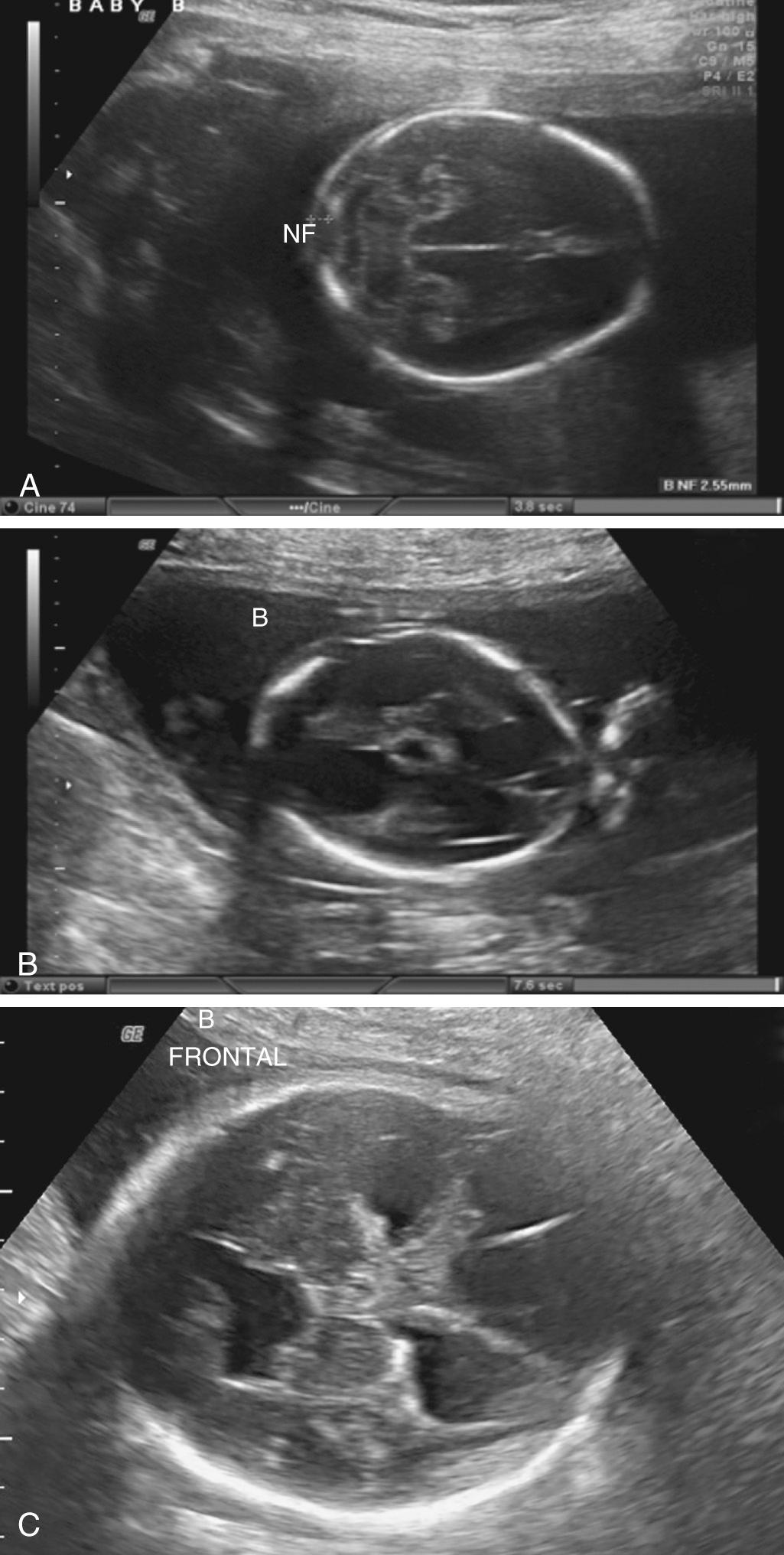
The most widely accepted hypothesis as to the cause of neurologic injury in surviving co-twins in a MC pregnancy is that significant hypotension occurs at the time of the demise. Following death of the first twin, the resulting low pressure in that twin's circulatory system causes blood from the survivor to rapidly backbleed into the dead twin through placental anastomoses. Depending on the severity and duration of the hypotension, the surviving twin is at risk for both demise and ischemic damage to vital organs, especially those requiring greater oxygen demand, such as the brain. It should be stressed that because the injury is coincident with the IUFD, rapid delivery of the co-twin following single IUFD in a MC pregnancy will not improve the outcome.
Ultrasound examination of the fetal brain may be suggestive of multicystic encephalomalacia but is not always definitive. Magnetic resonance imaging (MRI) of the fetal brain may also be useful in its detection. We currently offer neuroimaging with fetal MRI to all patients with MC placenta approximately 2 to 3 weeks after the demise of one fetus has been detected. Although we counsel patients that a normal MRI does not definitively rule out brain abnormalities, it is a positive prognostic finding.
It was originally estimated that the incidence of maternal DIC was 25% when a dead fetus was retained in a multiple gestation, but this is certainly a gross overestimation. Only a few isolated cases of laboratory changes consistent with a subclinical coagulopathy have been reported under these circumstances. It is also reassuring to note that no cases of clinically significant coagulopathy have been reported in the extensive literature on ST and MPR. The NAFTNet Consensus Statement on the management of complicated MC twins states that after IUFD of one twin, “routine monitoring for coagulopathy is not indicated.”
Optimal management for a single IUFD in multiple gestations is not well established, and recommendations are based mainly on expert opinion. Clinical management depends on the gestational age, maternal status, or detection of in utero compromise of the surviving fetus or fetuses. The goal is to optimize the outcome for the survivor while also avoiding unnecessary prematurity. Serial sonographic assessment of the surviving co-twin's growth is indicated, as is antenatal testing. However, when to initiate antenatal testing and the frequency of testing depends on clinical factors such as gestational age at the time of the IUFD.
The 2011 National Institute of Child Health and Human Development (NICHD) and SMFM workshop on timing of indicated late-preterm and early-term birth addressed the issue of a single IUFD in a twin pregnancy. If the IUFD occurs at 34 weeks or beyond, delivery should be considered. The 2016 ACOG Practice Bulletin on Multifetal Gestation gives a similar recommendation, stating that in the absence of other indications, a single IUFD in a twin pregnancy before 34 weeks should not prompt immediate delivery. These two documents do not otherwise specifically address delivery timing for twin pregnancies in which IUFD of one twin occurs earlier than 34 weeks. The NAFTNet Consensus Statement on management of complicated MC twins states that “expectant management to term is favored” when demise of one twin occurs. In our practices, a single IUFD in a MC diamniotic pregnancy at or after 34 weeks would be an indication for delivery. If IUFD of one twin occurs in the second or early third trimester of an otherwise uncomplicated MC diamniotic gestation, we typically recommend delivery at 37 weeks if growth and antenatal testing are reassuring, but we have a low threshold to deliver after 34 weeks. In a DC pregnancy, delivery timing should be individualized based on the likely cause of the IUFD, the appropriateness of fetal growth, and fetal testing of the surviving co-twin. Fig. 39.8 provides one approach to management of a DCDA twin gestation complicated by single IUFD in the second or third trimester.
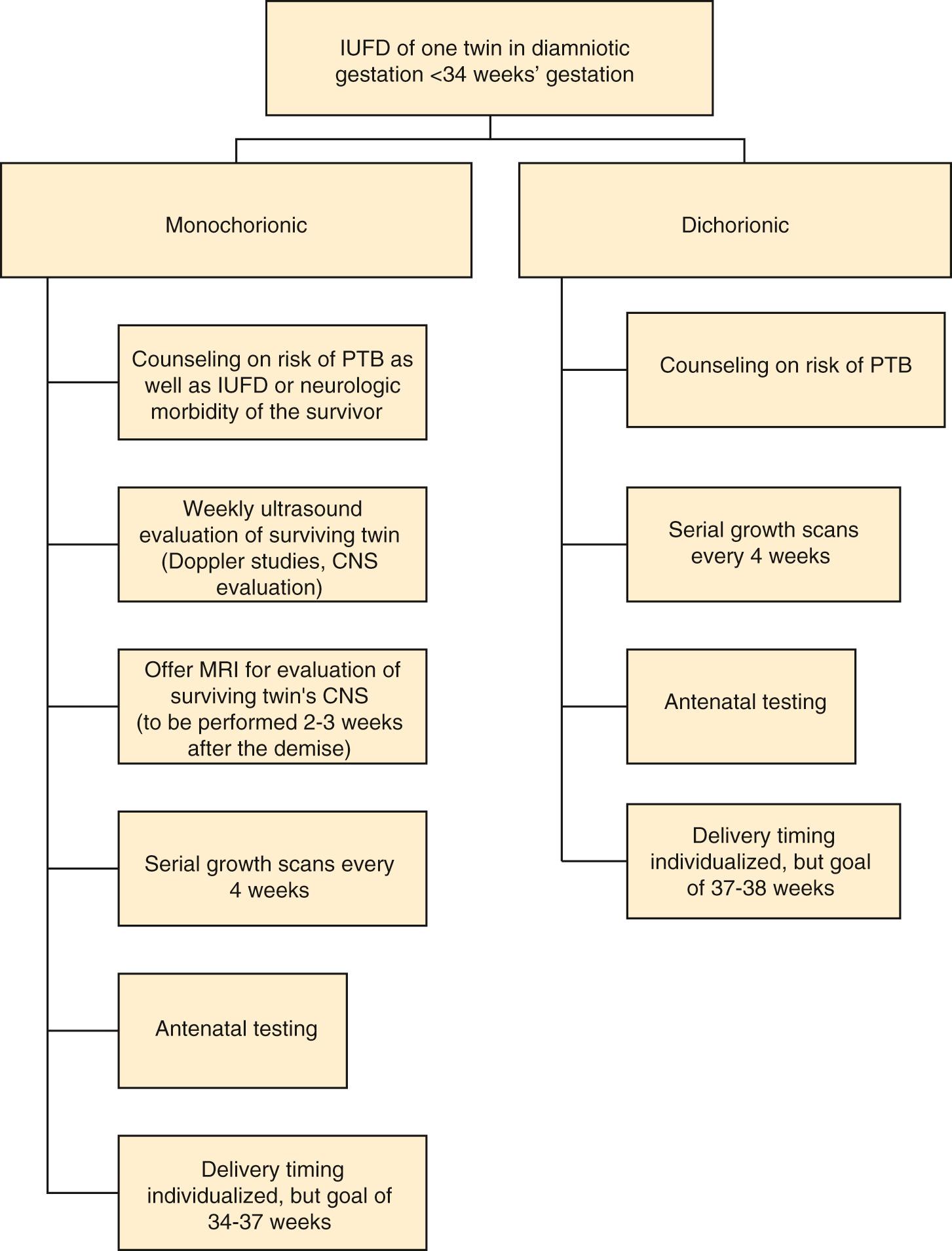
Become a Clinical Tree membership for Full access and enjoy Unlimited articles
If you are a member. Log in here